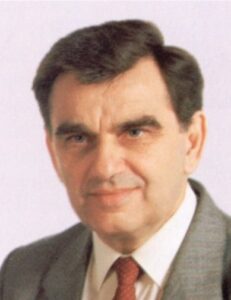Gyula Tofalvi
He started out as an economist, but had to change his major in his second year of university due to a thesis; from 1950 he became a student at the Budapest University of Technology (BME).
After graduating from university, he became a development engineer in the ionosphere research laboratory of the Electromechanical Company (EMV). In 1958, together with three development partners, he won the Grand Prix of the Brussels World Exhibition for the development of the IRX-type ionosphere research device. The following year, he received the Kossuth Prize, 2nd degree (shared) for this success. In that year, he supervised the development work of the first Hungarian television transmitter and antenna system (the device was completed in 1960).
In the late 1960s, he was already working on the development of color television transmitter equipment. In 1965, he was appointed chief engineer of EMV. Under his direction, the new equipment of the Kossuth transmitter in Lakihegy was completed in 1968, and then the development of the shortwave transmitter station in Jászberény began (he became a doctor of engineering based on the work on the antenna and feedline systems related to this, and then a candidate of technical sciences in 1974). In 1975, he left EMV.
Between 1975 and 1980 , he coordinated the development work of companies in the sector as the technical vice president of the Hungarian Telecommunications Association (MHE).
In 1980, he became the scientific director of the Telecommunications Research Institute (TKI).
Between 1992 and 1997, he was the founder and executive director of the Hungarian Space Research Institute (MŰI); he was the chairman of the Scientific Council for Space Research (ŚTT).
In addition, he was the editor-in-chief of the journal Híradástechnika from 1983, and the secretary-general and then president of the Híradástechnikai Tudományos Egyesület (HTE) from 1984 to 1990. He taught as an honorary university professor at BME and launched the broadcasting engineering training program. He was a founding member (1990), a member of the board and its vice-president for several terms of the Hungarian Academy of Engineers.
His awards: shared Kossuth Prize (Hungarian State, 1959); Tivadar Puskás Prize (HTE, 1977, 1991); MTESZ Prize (Association of Technical and Natural Science Associations, 1984); Loránd Eötvös Prize (Council of Ministers, 1985); Albert Fonó Prize (Hungarian Astronautical Society (MANT), 1995).
- The feature film Érik a fény (The Light Reaches) was made from his diary of his work, which tells the story of the engineers of the Kékes TV station and their struggle to achieve their goals (1970; director: Mihály Szemes).
- His self-confession was published under the title I am an Engineer (OMIKK Publishing, Budapest, 1989).
- Since the arts were always close to him, at his request, Kodály's Kállai duet was played on the first broadcast of every radio station.
Created: 2024.07.16. 16:29
Last modified: 2024.09.04. 18:32

